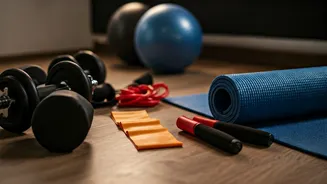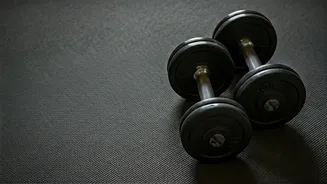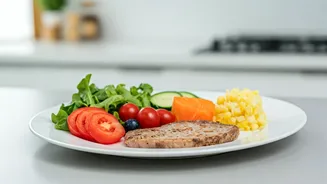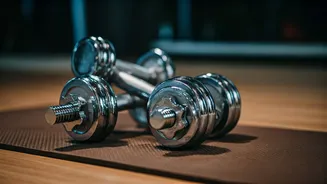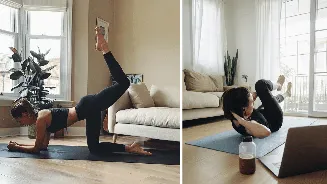Warm-up Essentials First
Before diving into the exercises, warming up your body is crucial. A warm-up prepares your muscles and reduces the risk of injuries. Start with 5-10 minutes
of light cardio such as jogging in place or jumping jacks to elevate your heart rate. Follow this with dynamic stretches that involve movement, like arm circles, leg swings, and torso twists. These stretches enhance flexibility and prime your muscles for the exercises ahead. A good warm-up enhances blood flow, increases body temperature, and prepares the joints, setting the stage for effective and safe workouts. Remember to stay hydrated throughout the process by sipping water before and during the workout to maximize your results.
Core-Focused Exercises
This section introduces a series of core-strengthening exercises pivotal for fat reduction in the lower abdomen. Begin with crunches; lie on your back, knees bent, and lift your upper body towards your knees, focusing on engaging your core. Perform 3 sets of 15 repetitions. Next, try reverse crunches: Lie flat, legs lifted, and bring your knees towards your chest, engaging your lower abdominal muscles; complete 3 sets of 15 reps. Then, incorporate leg raises; lying flat, lift your legs towards the ceiling while keeping your lower back pressed into the floor for 3 sets of 15 repetitions. These exercises directly target the lower abdominal region, contributing to a more toned appearance. Remember to maintain proper form to avoid strain and maximize effectiveness.
Planks and Variations
Planks are fundamental for core strength. Start with a standard plank, holding your body in a straight line from head to heels, supported by your forearms and toes; hold for 30-60 seconds, repeated three times. Side planks, which target the oblique muscles, involve supporting your body on one forearm, keeping your body in a straight line; hold for 30-60 seconds on each side, repeated three times. Plank variations like forearm planks, high planks and plank with leg lifts, add intensity and engage different muscle groups. Maintaining correct posture during planks is critical to ensure that your core muscles are fully activated. Regular planking is crucial for tightening and strengthening your core, ultimately aiding in reducing lower belly fat.
Cardio Burst Intervals
Incorporate High-Intensity Interval Training (HIIT) to enhance fat burning, including exercises like jumping jacks, high knees, and mountain climbers. For jumping jacks, do them for 30 seconds followed by 30 seconds of rest, repeated 3-5 times. High knees involve bringing your knees up towards your chest rapidly; perform this for 30 seconds, rest for 30 seconds, and repeat 3-5 times. Mountain climbers involve a plank position, bringing each knee towards your chest alternately for 30 seconds, then rest for 30 seconds, repeated 3-5 times. HIIT workouts alternate between short bursts of intense activity and brief recovery periods, which can increase calorie burn and boost metabolism even after your workout is complete. This combination ensures maximum fat burning potential.
Lower Body Workouts
Leg exercises are essential because they utilize major muscle groups, boosting your overall metabolism. Start with squats, standing with feet shoulder-width apart, and lower your hips as if sitting in a chair, keeping your back straight; perform 3 sets of 15 repetitions. Lunges can be forward, backward, or lateral, stepping forward and lowering your body until both knees are bent at 90 degrees; perform 3 sets of 10-12 repetitions per leg. Glute bridges are also a great option, lying on your back with knees bent and lifting your hips off the floor, squeezing your glutes; perform 3 sets of 15 repetitions. These exercises help burn calories, build muscle, and tone your lower body, contributing to overall fat loss. Consistent leg workouts help shape your body while promoting a healthy metabolism.
Cool-Down and Stretching
Concluding the workout with a cool-down is as important as the warm-up. This reduces muscle soreness and aids in recovery. Gentle stretching helps improve flexibility and prevents muscle tightness. Focus on static stretches, holding each stretch for 30 seconds, which includes hamstring stretches, quadriceps stretches, and calf stretches. After completing your exercises, ensure you engage in light cardio, like walking, to gradually decrease your heart rate. Cooling down helps in the removal of metabolic waste products from your muscles, preventing muscle stiffness and facilitating recovery. The cool-down phase is essential for optimal results and preparing your body for future workouts. Don't underestimate this critical part of your routine!
Consistency is Key
Consistency is the most vital factor for success. Aim to perform these exercises at least 3-4 times a week, ensuring that you do not overtrain, which may lead to injury. Combine these exercises with a balanced diet rich in fruits, vegetables, lean protein, and whole grains. Proper nutrition fuels your body, aids in recovery, and accelerates fat loss. Keep track of your progress by monitoring your weight and taking measurements to monitor changes. Regular exercise also boosts your mental health, reducing stress and improving your mood. By incorporating these exercises into your routine, you can start your journey to a leaner, healthier physique within 21 days.
Listen To Your Body
Pay close attention to how your body feels during workouts. If you experience pain, stop immediately and rest. Ensure you're well-hydrated before, during, and after each exercise session. Adequate rest is essential; aim for 7-8 hours of sleep each night to allow your body to recover and rebuild muscle. Varying your workout routine and incorporating different exercises will prevent boredom and challenge your muscles in new ways. Consulting with a healthcare professional or a certified fitness trainer can ensure that the exercises are suitable for your specific needs and fitness level. Modifying the exercises to accommodate any injuries or physical limitations is essential to avoid aggravation. Prioritize your body's signals.
Track Your Progress
Tracking your progress provides motivation and helps you understand how your body is responding to the exercises. Take measurements of your waist and other areas where you want to see results at the beginning of the 21-day period and then again at the end. Take photos regularly to visually track your transformation. Record the exercises you perform and the number of repetitions and sets you complete each session. Evaluate and adjust the exercises if you aren't seeing the desired results. Set achievable goals to keep yourself motivated. Celebrate milestones and acknowledge your achievements. Tracking progress promotes a sense of accomplishment and drives consistent engagement.
